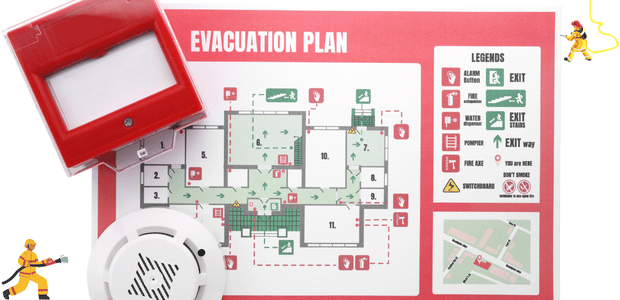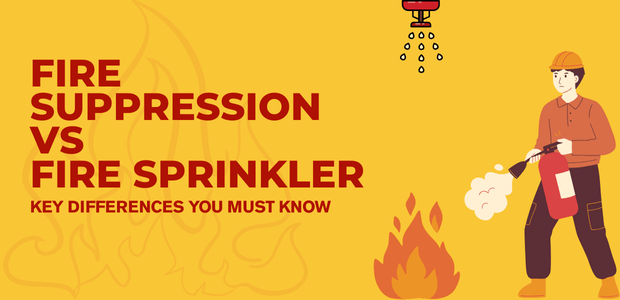Fire and Emergency Evacuation Plan

- March 10, 2025
- Interface Digital
A well-structured fire and emergency evacuation plan is required in every house and office. In an emergency, fear can worsen the situation, but a detailed strategy ensures that everyone understands what to do.
Regular fire drills, clear evacuation routes, and emergency contacts are essential features. Keeping fire safety equipment like fire extinguishers and smoke alarms also increases defense against fire.
A proper plan ensures that everyone knows their role. Furthermore, they also guide them to follow the safest way to exit. It avoids injuries, death, and property damage.
Why Every Workplace and Home Needs an Evacuation Plan
The risks of not having an evacuation plan
Despite their efforts, a lot of businesses make serious mistakes while planning emergency fire action plans:- Damaging Infrastructures: Rebuilding these infrastructure can take months or even years, damaging files, data, machinery, equipment, and goods. Without insurance or backup measures, firms may suffer permanent damage.
- Damages to your reputation: A negative reputation in the media can significantly slow down business recovery and limit access to new clients. It also affects the recovery process, affecting the tangible aspects of the business.
- Death: Employers are responsible for the safety and protection of their employees on the job. They may be able to save lives or give themselves an opportunity to survive by completing compliance standards and creating a proper fire evacuation plan for a workplace.
Legal and Safety Requirements for Evacuation Planning
Governments and safety organizations enforce strict fire evacuation procedures to protect lives. Businesses, residential or public buildings must comply with local and up-to-date fire regulations, which often include:- The premises must have clear evacuation routes and emergency exits.
- As per the fire escape plan, the building admin must install fire alarms, extinguishers, and sprinkler systems for their premises.
- Regular fire drills and employee training must be conducted at least once a year.
- Designated fire wardens and floor monitors must conduct fire drill procedures in the building.
Fire Safety Equipment
Fire safety equipment is the backbone of any fire exit plan. Essential devices include:- Smoke detectors: Smoke detectors can detect fire and give early warnings to people.
- Fire extinguishers: Installing Class A fire extinguishers allows small fires to be contained before spreading.
- Sprinklers: Once fire is detected, sprinklers automatically extinguish fires.
- Fire alarms: These alarms alert everyone in the building to evacuate immediately.
- Escape ladders: In case fire spreads in high-rise buildings, escape ladders can help save lives.
Key Elements of a Fire and Emergency Evacuation Plan
A well-designed building evacuation plan includes several key elements that ensure a safe and organized response during an emergency.1. Identifying Fire Hazards
Before creating an emergency exit plan, conduct a risk assessment to identify potential fire hazards. Key prevention measures include:- Inspect electrical systems for any faults in them. If there are faults, then repair them instantly.
- Flammable items should never be kept away from heating sources.
- Make sure to maintain proper storage of hazardous chemicals.
- Setting fire prevention guidelines, like banning open flames in the workplace, can help avoid fire early on.
2. Establishing Emergency Exit Routes
Having clear and accessible exit routes is crucial. A good evacuation plan should include:- Emergency lighting must be installed in all escape routes. So that people can follow and escape safely.
- Fire evacuation plan drawings must show all escape routes, and exits in the building.
3 . Roles and Responsibilities During an Evacuation
To prevent chaos, assign specific roles to individuals as per the home fire escape plan:- Fire Wardens: The chief fire warden is responsible for all fire-related factors, like planning, security checks, and ensuring bathrooms are locked. Lastly, the headcount is made for cross-verification.
- Assistant Fire Warden: This person acts as an administrator in the company emergency communication system. They call for a mass alert system to inform staff, communicate with the fire department, and record reports.
- Route guides: They look into whether the evacuation is done calmly and orderly. They also make sure that routes are without obstacles.
- Floor monitors (especially in workplaces): The floor monitor is responsible for evacuating staff and ensuring they close doors and escape from fireplaces. Once they reach a safe zone, they should inform the chief fire warden, and then only the floor monitor leaves.
4. Fire Alarm and Communication System
An alarm system that fails to function during emergencies is worse than no fire alarm system at all, together. These systems must be carefully designed, installed, and maintained. These systems can detect an approaching fire before it becomes visible to those living there. This provides more time and a safer setting for those who live in the building to escape to safety.5. Conducting Fire Drills and Training
Practicing fire drills as per the fire safety evacuation plan helps people respond calmly during a real emergency. Key benefits:- Fire evac plan shows instructions on how to reach exit routes safely.
- It helps uncover weaknesses in the drawing emergency evacuation plan.
- Teach the people Dos and Don'ts of Fire Safety Instruction Guide; it increases fire safety awareness among them.
Special Considerations for Different Settings
Fires can occur anywhere, but some places are more vulnerable than others. Below are the special considerations needed to implement in places like workplaces, homes, and public spaces:1. Workplaces and Offices
- Overloaded electrical outlets can ignite fire; if there is a short-circuit in these outlets repair it.
- If staff are using electrical appliances and left unattended, it can cause a fire. Once you use the appliances, switch them off immediately.
- If there are flammable materials or chemicals in workplaces, they can ignite the fire. Store flammable and preserve chemicals
2. Residential Buildings
- Cooking accidents like forgetting to turn off the gas will invite fire. Once finished cooking, switch off the gas.
- If faulty wiring is not repaired on time, it can cause fire. Hence, repair it or replace it with new ones.
- Smoking is harmful to people, but at the same time, it is also harmful to your home (if smoked indoors). If someone is smoking inside, tell them to smoke outside home.
- If you forget to switch off heating equipment like heat pumps, or boilers, you are about to invite a dangerous guest called fire. Switch it off after use.
3. Schools and Public Places
- Public spaces with limited or narrow exits can lead to stampedes, injuries, and deaths. Assign route guides to lead the people out of the chaos, in an orderly manner.
- As said in workplaces, if flammable materials are exposed in public, it may create fire or explosion. Store them away from public spaces.
- In the event of fire incidents, use fire safety equipment like fire extinguishers to fight against fire.









